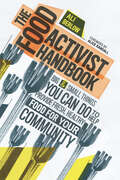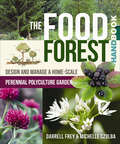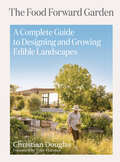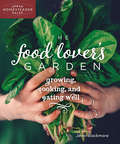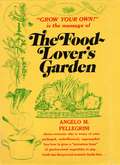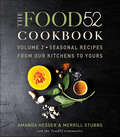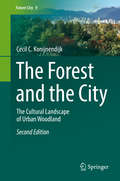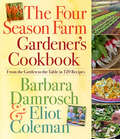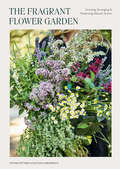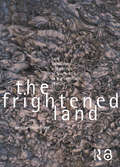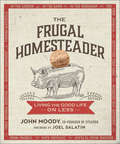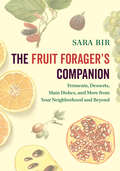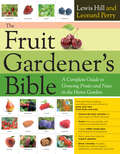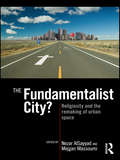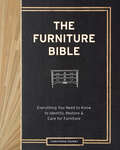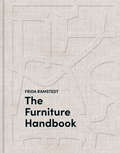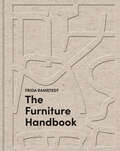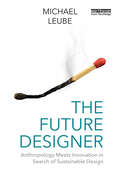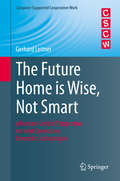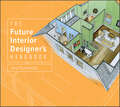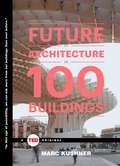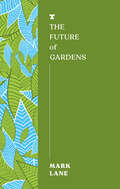- Table View
- List View
The Food Activist Handbook: Big & Small Things You Can Do to Help Provide Fresh, Healthy Food for Your Community
by Alice Randall Ali BerlowOne person really can make a difference. From starting neighborhood kitchens to connecting food pantries with local family farms, Ali Berlow offers a variety of simple and practical strategies for improving your community’s food quality and security. <P><P>Learn how your actions can keep money in the local economy, reduce the carbon footprint associated with food transportation, and preserve local landscapes. <P><P>The Food Activist Handbook gives you the know-how and inspiration to create a better world, one meal at a time.
The Food Forest Handbook: Design and Manage a Home-Scale Perennial Polyculture Garden
by Darrell Frey Michelle CzolbaLearn how to mix and match plants in unique combinations to establish bountiful landscapes and create genuine self-reliance in years to come.A food forest is a productive landscape developed around a mix of trees and perennials. Rooted in permaculture principles, this integrated approach to gardening incorporates a variety of plants such as fruit and nut trees, shrubs, vines, and perennial herbs and vegetables. Food forests can help increase biodiversity, protect valuable habitat for beneficial insects, and promote food security and resilience, all while providing an abundant harvest.The Food Forest Handbook is a practical manual for the design and management of a home-scale perennial polyculture garden. Simple, straightforward instructions guide the reader through:Getting started—site assessment and planningTending the forest garden—maintaining soil health, succession planning, mulching, pruning and moreThe fruits of your labor—crop profiles, harvest, storage, nutrition and recipesThis timely book makes the concept of food forests accessible to everyone, offering a unique approach to low-maintenance, high-yield, sustainable food production.“What happens if we were to drop the boundary between the built environment and nature? Wouldn’t we all be much better off? The Food Forest Handbook guides our first steps along that path.” —Albert Bates, author of The Biochar Solution“Through this in-depth practical book you will learn the strategies for effective planning, design, establishment and management of perennial polycultures . . . I recommend this book to all those who are bringing diversity to their planting schemes.” —Jude Hobbs, permaculture land-use consultant, designer, and educator, Cascadia Permaculture
The Food Forward Garden: A Complete Guide to Designing and Growing Edible Landscapes
by Christian DouglasDiscover a high-style approach to vegetable gardening from award-winning landscape designer Christian Douglas. What if, instead of relegating our vegetable patch to a remote corner of the backyard, we brought it forward? What if we integrated edibles into our decorative landscapes, letting vegetables, herbs, fruits, and berries share prime real estate alongside our patios, pools, even our front walkways? Equal parts inspiration and instruction, and filled with an abundance of ideas and information, The Food Forward Garden is a lushly illustrated guide to how we can make better use of our outdoor spaces without sacrificing style. In this comprehensive manual, award-winning landscape designer Christian Douglas shows us how the intrinsic beauty and seasonal rhythms of edibles bring a new level of purpose, meaning, and stunning visual pleasure to the home garden.
The Food Lover's Garden: Growing, Cooking, and Eating Well (Urban Homesteader Hacks)
by Jenni Blackmore&“Your &‘one stop shop&’ for everything from seed to plate . . . This book will leave you . . . ready to launch your own journey to food self-sufficiency.&” —Lisa Kivirist, author Soil Sisters Put off by the origin-unknown, not-so-fresh, pesticide-laden herbs at the grocery store? Hungry for delicious high-quality vegetables and looking to have some control over where your food comes from? Foodie meets novice gardener in this deliciously accessible, easy-to-use guide to planting, growing, harvesting, cooking, and preserving 20+ popular, easy-to-grow vegetables and herbs. Taking the first-time gardener from growing to cooking delicious, nutritious, and affordable meals using these herbs and vegetables, this book is a celebration of food in all its stages. The Food Lover&’s Garden guides you through: Getting started with easy step-by-step growing instructions from balcony to backyard Simple, tasty cooking recipes incorporating each vegetable and herb Meal combinations of two or more of the featured herb and vegetable dishes Selecting essential kitchen tools and gadgets to maximize the herb and vegetable harvesting Canning and pickling recipes for preserving the rest. From the humble potato to pungent garlic to the beauty of the beet, classic vegetables take a delicious turn with innovative cooking recipes. Truly food for all seasons and palates. Foodies, novice gardeners, urban homesteaders, and supporters of sustainable living—take back your right to high-quality food with The Food Lover&’s Garden. &“The crisp photographs, lushly painted illustrations, and delicious text lead the reader from the garden to the kitchen and pantry with anticipation of culinary delight.&”—Darrell E. Frey, author of Bioshelter Market Garden
The Food52 Cookbook, Volume 2: Seasonal Recipes from Our Kitchens to Yours (Food52 Ser. #2)
by Amanda Hesser Merrill StubbsA &“wonderful&” new collection of seasonal recipes from America&’s best home cooks, compiled by the team behind the James Beard Award–winning website (Publishers Weekly, starred review).The Food52 Cookbook was named one of the Best Cookbooks of the Year by NPR and the Washington Post. Now the pioneers of the online community cookbook return with a second helping of delicious, seasonal recipes from the country&’s most inventive home cooks. The Food52 Cookbook, Volume 2 features contest winners and community favorites including: Late-Night Coffee-Brined Chicken Roasted Carrot Soup Herbed Beef Skewers with Horseradish Cream Kentucky Hot Toddy Burnt Caramel Pudding Crispy Salt-and-Pepper French Toast Korean Fried Chicken Wings, and many more &“Full of interesting, unique dishes and candid comments from Food52.com groupies, The Food52 Cookbook, Volume 2 inspires as easily as it charms . . . a carefully edited selection of the crème de la crème efforts by home cooks.&” —The Christian Science Monitor &“Accessible and appealing. . . . beautifully photographed and organized by season.&” —Publishers Weekly (starred review)
The Forager's Almanac: A year of sustainable foraging, wildcraft and recipes
by Danielle GallacherGet in tune with the rhythms of nature with this month-by-month guide to foraging.Learn how to identify wild plants correctly, harvest them at their prime, and use them in delicious recipes and relaxing wildcrafting projects. Each plant is accompanied by photography to help with accurate identification. Gathering wild food summons us to become active participants in our environment, fostering a profound sense of connection to the natural world around us. At the heart of foraging lies an intricate understanding of the changing seasons, the landscape, and the delicate ecosystems that thrive within.Danielle Gallacher has been foraging for over 20 years, and in The Forager's Almanac she shares her expertise on how to safely harvest our countryside's edible bounties, and how to use them in your cooking - such as pickles, preserves, ciders and lemonades. Danielle also shares her top wildcrafting ideas, including resin firelighters, home remedies, salves and balms to sooth irritated skin.Fully illustrated throughout and divided into 12 months, you will find practical information on: - how to get started and what kit to bring- when and where to forage each plant, with photographs for accurate identification- medicinal and nutritional information for edible plants- imaginative recipes using wild foods- craft ideas for enjoying your harvestThe Forager's Almanac provides all the tools you need to live in greater harmony with the land throughout the seasons, year after year.
The Forager's Almanac: A year of sustainable foraging, wildcraft and recipes
by Danielle GallacherGet in tune with the rhythms of nature with this month-by-month guide to foraging.Learn how to identify wild plants correctly, harvest them at their prime, and use them in delicious recipes and relaxing wildcrafting projects. Each plant is accompanied by photography to help with accurate identification. Gathering wild food summons us to become active participants in our environment, fostering a profound sense of connection to the natural world around us. At the heart of foraging lies an intricate understanding of the changing seasons, the landscape, and the delicate ecosystems that thrive within.Danielle Gallacher has been foraging for over 20 years, and in The Forager's Almanac she shares her expertise on how to safely harvest our countryside's edible bounties, and how to use them in your cooking - such as pickles, preserves, ciders and lemonades. Danielle also shares her top wildcrafting ideas, including resin firelighters, home remedies, salves and balms to sooth irritated skin.Fully illustrated throughout and divided into 12 months, you will find practical information on: - how to get started and what kit to bring- when and where to forage each plant, with photographs for accurate identification- medicinal and nutritional information for edible plants- imaginative recipes using wild foods- craft ideas for enjoying your harvestThe Forager's Almanac provides all the tools you need to live in greater harmony with the land throughout the seasons, year after year.
The Forest and the City: The Cultural Landscape Of Urban Woodland
by Cecil C. KonijnendijkAmsterdamse Bos, Bois de Boulognes, Epping Forest, Hong Kong’s country parks, Stanley Park: throughout history cities across the world have developed close relationships with nearby woodland areas. In some cases, cities have even developed – and in some cases are promoting – a distinct ‘forest identity’. This book introduces the rich heritage of these city forests as cultural landscapes, and shows that cities and forests can be mutually beneficial.Essential reading for students and researchers interested in urban sustainability and urban forestry, this book also has much wider appeal. For with city forests playing an increasingly important role in local government sustainability programs, it provides an important reference for those involved in urban planning and decision making, public affairs and administration, and even public health. From providers of livelihoods to healthy recreational environments, and from places of inspiration and learning to a source of conflict, the book presents examples of city forests from around the world. These cases clearly illustrate how the social and cultural development of towns and forests has often gone hand in hand. They also reveal how better understanding of city forests as distinct cultural and social phenomena can help to strengthen synergies both between cities and forests, and between urban society and nature.
The Formation of Papal Authority in Late Antique Italy
by Kristina SessaThis book is the first cultural history of papal authority in late antiquity. While most traditional histories posit a 'rise of the papacy' and examine popes as politicians, theologians and civic leaders, Kristina Sessa focuses on the late Roman household and its critical role in the development of the Roman church from c.350-600. She argues that Rome's bishops adopted the ancient elite household as a model of good government for leading the church. Central to this phenomenon was the classical and biblical figure of the steward, the householder's appointed agent who oversaw his property and people. As stewards of God, Roman bishops endeavored to exercise moral and material influence within both the pope's own administration and the households of Italy's clergy and lay elites. This original and nuanced study charts their manifold interactions with late Roman households and shows how bishops used domestic knowledge as the basis for establishing their authority as Italy's singular religious leaders.
The Four Season Farm Gardener's Cookbook: From the Garden to the Table in 120 Recipes
by Eliot Coleman Barbara DamroschBarbara Damrosch and Eliot Coleman are America’s foremost organic gardeners—and authorities. Barbara is the author of The Garden Primer, and Eliot wrote the bible for organic gardening, The New Organic Grower. Today they are the face of the locavore movement, working through their extraordinary Four Season Farm in Maine. And now they’ve written the book on how to grow what you eat, and cook what you grow. <P><P>The Four Season Farm Gardener’s Cookbook is two books in one. It’s a complete four-season cookbook with 120 recipes from Barbara, a master cook as well as master gardener, who shows how to maximize the fruits—and vegetables—of your labors, from Stuffed Squash Blossom Fritters to Red Thai Curry with Fall Vegetables to Hazelnut Torte with Summer Berries. <P><P>And it’s a step-by-step garden guide that works no matter how big or small your plot, with easy-to-follow instructions and plans for different gardens. It covers size of the garden, nourishing the soil, planning ahead, and the importance of rotating crops—yes, even in your backyard. And, at the core, individual instructions on the crops, from the hardy and healthful cabbage family to fourteen essential culinary herbs. <P>Eating doesn’t get any more local than your own backyard.
The Fragrant Flower Garden: Growing, Arranging & Preserving Natural Scents
by Stefani Bittner Alethea HarampolisMake your garden and home look and smell heavenly with this accessible gardening guide that explains how to grow fragrant flowers outdoors and bring natural scents indoors by creating floral arrangements, scented beauty products, and more.&“A practical guide to a life infused with the scent of flowers.&”—Kelly Smith Trimble, senior editorial director for HGTV and author of Vegetable Gardening Wisdom and The Creative Vegetable GardenerThere is nothing like the beauty and scent of a flower-filled garden and home. The Fragrant Flower Garden shows you how to grow flowers that are a feast for the nose as well as the eyes, from a naturally perfumed carpet of sweet alyssum and the warm, spicy scent of gardenia to the heavenly aroma of lilacs. A beautiful garden is one where you can find joy in every sense—literally. The Fragrant Flower Garden makes this dream a reality with garden design guidance for a year&’s worth of flowers, foliage, and fragrance. Then, reap the wellness benefits of your fragrant flowers through DIY projects such as making floral arrangements, perfumes, tub soaks, and tinctures.Whether you prefer the smell of classic lavender or something more adventurous like chocolate cosmos, The Fragrant Flower Garden opens the door to creating a scented flower garden that is a delight for all.
The Frightened Land: Land, Landscape and Politics in South Africa in the Twentieth Century
by Jennifer BeningfieldAn investigation into the spatial politics of separation and division in South Africa, principally during the apartheid years, and the effects of these physical and conceptual barriers on the land. In contrast to the weight of literature focusing on post-apartheid South Africa, the focus of this book includes the spatial, political and cultural landscape practices of the apartheid government and also refers to contemporary work done in Australia, England and the US. It probes the uncertainty and ambiguity of identities and cultures in post-apartheid society in order to gain a deep understanding of the history that individuals and society now confront. Drawing on a wealth of research materials including literature, maps, newspapers, monuments, architectural drawings, government legislation, tourist brochures, political writing and oral histories, this book is well illustrated throughout and is a unique commentary on the spatial politics of a time of enormous change.
The Frugal Homesteader: Living the Good Life on Less
by John Moody&“Practical advice . . . from the farm field to foraging in the forest . . . a must-have for anyone looking to transition from homeowner to homesteader.&”—Scott Mann, host of The Permaculture Podcast Build your homesteading dreams with all the affordable DIY innovations, tips, and stories you need to successfully launch you on a path to self-sufficiency. Raise and grow your own food, connect with nature, and consume less while producing more!The Frugal Homesteader is a fun, inspirational, and educational guide filled with a lifetime of learning that comes along with becoming a homesteader. Following dozens of successful families who have been motivated to make do, make new, and make more while saving money and living off the land, this book covers such topics as:Outfitting your garden Equipping your barn and outbuildings Protecting and providing for your animals Harvesting rainwater Heating with wood Foraging Producing more of what you need to thrive in harder times. Whether you&’re just starting out and looking for new, sustainable, and affordable ideas, approaches, and techniques, or you&’re a small-scale farmer in regenerative agriculture, The Frugal Homesteader is the DIY manual to help you succeed. &“This book is worth its weight in gold . . . an account of direct lived experience: jam-packed with tips and tricks from doing the homestead life each and every day.&”—Ben Falk, homesteader and author of The Resilient Farm and Homestead &“This is a rich bounty of ideas that will be equally usefully to old hands and shiny new start-ups alike, whether on rural acreage or urban lot.&”—Jenni Blackmore, author of The Food Lover&’s Garden
The Fruit Forager's Companion: Ferments, Desserts, Main Dishes, and More from Your Neighborhood and Beyond
by Sara BirFrom apples and oranges to pawpaws and persimmons"Sara Bir&’s voice is quirky, informed, and fresh. The Fruit Forager&’s Companion will push any soul who is interested in foraging into the curious world of fruits. . . . You want someone with passion and appetite to lead you on a foraging quest, and Sara has plenty of both."—Deborah Madison, author of Vegetable Literacy and In My KitchenHalf of the fruit that grows in yards and public spaces is never picked or eaten. Citrus trees are burdened with misshapen lemons, berries grow in tangled thickets on the roadside, and the crooked rows of abandoned orchards fill with fallen apples. At the same time, people yearn for an emotional connection that&’s lacking in bland grocery store bananas and tasteless melons.The Fruit Forager&’s Companion is a how-to guide with nearly 100 recipes devoted to the secret, sweet bounty just outside our front doors and ripe for the taking, from familiar apples and oranges to lesser-known pawpaws and mayhaws. Sara Bir—a seasoned chef, gardener, and forager—primes readers on foraging basics, demonstrates gathering and preservation techniques, and presents a suite of recipes including habanero crabapple jelly, lime pickle, pawpaw lemon curd, and fermented cranberry relish.Bir encourages readers to reconnect with nature and believes once the foraging mindset takes control, a new culinary world hiding in plain sight will reveal itself. Written in a witty and welcoming style, The Fruit Forager&’s Companion is a must-have for seekers of both flavor and fun.Winner — IACP 2019 Reference & Technical Cookbook Award
The Fruit Gardener's Bible: A Complete Guide to Growing Fruits and Nuts in the Home Garden
by Lewis Hill Leonard PerryEnjoy bushels of crispy apples and baskets of juicy blueberries from your own backyard. Authors Lewis Hill and Leonard Perry provide everything you need to know to successfully grow delicious organic fruit at home, from choosing the best varieties for your area to planting, pruning, and harvesting a bountiful crop. With tips on cultivating strawberries, raspberries, grapes, pears, peaches, and more, this essential reference guide will inspire year after year of abundantly fruitful gardening.
The Fundamentalist City?: Religiosity and the Remaking of Urban Space
by Nezar AlSayyadThe relationship between urbanism and fundamentalism is a very complex one. This book explores how the dynamics of different forms of religious fundamentalisms are produced, represented, and practiced in the city. It attempts to establish a relationship between two important phenomena: the historic transition of the majority of the world’s population from a rural to an urban existence; and the robust resurgence of religion as a major force in the shaping of contemporary life in many parts of the world. Employing a transnational interrogation anchored in specific geographic regions, the contributors to this volume explore the intellectual and practical challenges posed by fundamentalist groups, movements, and organizations. They focus on how certain ultra religious practices of Christianity, Hinduism, Islam, and Judaism have contributed to the remaking of global urban space. Their work suggests that it is a grave oversimplification to view religious orthodoxies or doctrines as the main cause of urban terrorism or violence. Instead they argue that such phenomena should be understood as a particular manifestation of modernity’s struggles. Nezar AlSayyad and Mejgan Massoumi’s book provides fascinating reading for those interested in religion and the city, with thought provoking pieces from experts in anthropology, geography sociology, religious studies, and urban studies.
The Furniture Bible: Everything You Need to Know to Identify, Restore & Care for Furniture
by Martha Stewart Jen Renzi Christophe PournyChristophe Pourny learned the art of furniture restoration in his father’s atelier in the South of France. In this, his first book, he teaches readers everything they need to know about the provenance and history of furniture, as well as how to restore, update, and care for their furniture—from antiques to midcentury pieces, family heirlooms or funky flea-market finds. The heart of the book is an overview of Pourny’s favorite techniques—ceruse, vernis anglais,and water gilding, among many others—with full-color step-by-step photographs to ensure that readers can easily replicate each refinishing technique at home. Pourny brings these techniques to life with a chapter devoted to real-world refinishing projects, from a veneered table to an ebonized desk, a gilt frame to a painted northern European hutch. Rounding out this comprehensive guide is care and maintenance information, including how to properly clean leather, polish hardware, fix a broken leg, and replace felt pads, as well as recipes to make your own wax, shellac, varnish, stain, and more.
The Furniture Handbook: A Guide to Choosing, Arranging, and Caring for the Objects in Your Home
by Frida RamstedtThe comprehensive guide to living with furniture, no matter your style, from the author of The Interior Design Handbook. Interior-design sensation Frida Ramstedt changed how we think about designing a harmonious home with her book The Interior Design Handbook. Now she brings that same authoritative and comprehensive focus to this complementary guide that&’s all about the most essential and functional items within your home. No matter your style of home, we all want our spaces to feel inviting and comfortable. And the key to that is quality furniture that supports your lifestyle. The Furniture Handbook shares the foundational rules of choosing, arranging, and caring for the furniture in every room of your home. From selecting the perfect size dining table and seating that fits your family to arranging your living room pieces for the best flow, the basic principles that interior designers use and that everyone should master are provided.• Know what to pay extra attention to when choosing and rearranging furniture and what common complaints people have so you can avoid them.• Understand the dimensions and details of furniture design that determine whether a piece is comfortable or not.• Select quality upholstery that looks beautiful and will endure wear and tear from pets, kids, and daily life.• Learn how to match the scale of different pieces and plan what goes where before you start moving your furniture, so you never regret the time and money you have invested. Complete with simple and elegant illustrations, The Furniture Handbook is your key to creating beautiful, personal spaces in your home.
The Furniture Handbook: A Guide to Choosing, Arranging, and Caring for the Objects in Your Home
by Frida RamstedtThe comprehensive guide to living with furniture, no matter your style, from the author of The Interior Design Handbook.Interior-design sensation Frida Ramstedt changed how we think about designing a harmonious home with her book The Interior Design Handbook. Now she brings that same authoritative and comprehensive focus to this complementary guide that&’s all about the most essential and functional items within your home.No matter your style of home, we all want our spaces to feel inviting and comfortable. And the key to that is quality furniture that supports your lifestyle. The Furniture Handbook shares the foundational rules of choosing, arranging, and caring for the furniture in every room of your home. From selecting the perfect size dining table and seating that fits your family to arranging your living room pieces for the best flow, the basic principles that interior designers use and that everyone should master are provided.Know what to pay extra attention to when choosing and rearranging furniture and what common complaints people have so you can avoid them.Maximize form and function for the pieces in your home, so you have furniture that is practical, beautiful, and cohesive. Choose the right scale and materials for your space, regardless of how big or small.Understand the dimensions and details of furniture design that determine whether a piece is comfortable or not.Select quality upholstery that looks beautiful and will endure wear and tear from pets, kids, and daily life.Make better choices for every room in your home and create the space you want to live inComplete with simple and elegant illustrations, The Furniture Handbook is your key to creating beautiful, personal spaces in your home.
The Future Designer: Anthropology Meets Innovation in Search of Sustainable Design
by Michael LeubeDuring periods of environmental and societal upheaval, design has the potential to be a formidable catalyst towards a sustainable future. However, to unleash its full power, significant shifts in both theory and practice are imperative. This book adopts a unique approach, blending anthropological perspectives with philosophy and cognitive science, and advocates for a thorough transformation of the existing design curriculum.Supported by a vast body of literature in evolutionary science and design research, the book presents a blueprint for fostering more sustainable patterns of production and consumption. This blueprint is grounded in human virtues rather than vices and proposes a new curriculum tailored towards pro-sociality and sustainability. Leveraging his extensive professional background and expertise in the circular economy, Michael Leube offers practical examples, methods and tools for implementing sustainable approaches in the practical work of experienced designers. Showcasing cutting-edge innovations for pro-social and humanitarian design, the book ultimately argues that if we change the objective of design from creating desire to creating value, we can solve many of the most pressing social problems, from the cooperation of citizens to sustainable cities.The book will be useful for those studying and teaching design and anthropology, and it will also be an important tool for practicing designers and engineers interested in learning how to design for social and ecological awareness.
The Future Home is Wise, Not Smart
by Gerhard LeitnerThis book introduces the concept of the wise home. Whilst smart homes focus on automation technologies, forcing users to deal with complex and incomprehensible control and programming procedures, the wise home is different. By going beyond intelligence (or smartness) the wise home puts technology in the background and supports explicit (enhanced user-experience) as well as implicit (artificial intelligence) interaction adequate to the end-user's needs. The theoretical basis of the wise home is explored and examples for its application for future living are presented based on empirical studies and field work carried out by the author. Principles of HCI and the meaning of the home from differing scientific perspective are discussed and a research model (based on the concept of user experience (UX)) and iterations is introduced. This has resulted in field deployment guides being produced through a systematic development process. The Future Home is Wise, not Smart will be essential reading to home system developers, designers and researchers, responsible for smart home deployment or Ambient Assisted Living (AAL) who will get insights on how to follow a novel approach in developing and adapting smart home systems to their users' needs. Students with an interest in software design for pervasive systems will benefit by receiving information on how to develop and customise systems for the specific needs of living environments.
The Future Interior Designer's Handbook
by Jana RosenblattCalling all aspiring interior designers! Get ready to dive into the captivating world of interior design with a book that introduces you to the role, techniques, and skills of interior design. You are invited to follow Taylor, a talented interior designer, as she transforms the unfinished attic of her home into a stunning living space. Step by step, readers will learn the ins and outs of the design process, gaining invaluable knowledge along the way. Unleash your creativity as you explore the three main drawings used by interior designers: the floor plan, section, and elevation. Discover the art of drawing to scale, enabling you to accurately represent your vision on paper. From initial planning to the final touches, this book guides you through each stage, teaching essential design techniques, basic color theory, mood board creation, and the architectural styles that shape modern interiors. The Future Interior Designer's Handbook is the perfect introduction to the captivating field of interior design. While it caters to the middle grades, ages 8–12, this book's wealth of knowledge and inspiration will resonate with design enthusiasts of all ages, including adults who are eager to explore their creative potential.
The Future of Architecture in 100 Buildings (TED Books)
by Marc KushnerThe founder of Architizer.com and practicing architect draws on his unique position at the crossroads of architecture and social media to highlight 100 important buildings that embody the future of architecture.We’re asking more of architecture than ever before; the response will define our future. A pavilion made from paper. A building that eats smog. An inflatable concert hall. A research lab that can walk through snow. We’re entering a new age in architecture—one where we expect our buildings to deliver far more than just shelter. We want buildings that inspire us while helping the environment; buildings that delight our senses while serving the needs of a community; buildings made possible both by new technology and repurposed materials. Like an architectural cabinet of wonders, this book collects the most innovative buildings of today and tomorrow. The buildings hail from all seven continents (to say nothing of other planets), offering a truly global perspective on what lies ahead. Each page captures the soaring confidence, the thoughtful intelligence, the space-age wonder, and at times the sheer whimsy of the world’s most inspired buildings—and the questions they provoke: Can a building breathe? Can a skyscraper be built in a day? Can we 3D-print a house? Can we live on the moon? Filled with gorgeous imagery and witty insight, this book is an essential and delightful guide to the future being built around us—a future that matters more, and to more of us, than ever.
The Future of Gardens (The FUTURES Series)
by Mark LaneA bold new look at the changes confronting gardening — including climate change and AI — by acclaimed horticulturalist, TV host, and disabilities activist Mark Lane . . . .Gardening is about choices. Which plants to choose for your soil type and conditions? Where to place them to maximise their growth? What to feed them, and when to water them? And how can all of this be done in a sustainable way? In The Future of Gardens, broadcaster and designer Mark Lane examines present-day considerations alongside those gardeners will need to make in the future.As Earth heats up and populations soar, water will become scarcer on many parts of the planet, and efficient management of it will be key: drought-tolerant planting and smart irrigation systems will likely become commonplace, as will vertical and otherwise space-restricted gardening. And as our world faces stressed or collapsing ecosystems, gardens will be crucial in improving wildlife populations – but only if we let them.Tech will play its part, too. AI-powered apps already provide tips to the green-fingered, but its dominance is a concern. How might we find a happy coexistence? Lane also imagines the potential for gardening in space: what challenges will interstellar travellers face as they cultivate plants on spacecrafts, or even on distant worlds?The Future of Gardens looks at this evergreen discipline with a bold, vibrant and inquisitive eye. Lane&’s own vision for inclusivity, sustainable practice and forward-looking design shines throughout this extraordinary addition to the FUTURES series.
